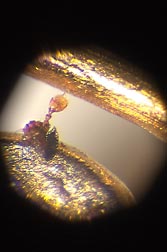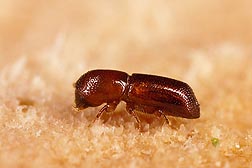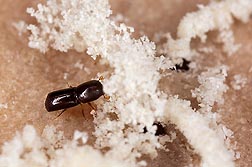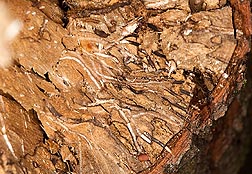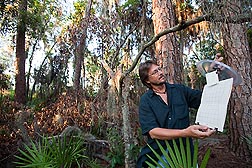Addressing a New Threat to Avocado: Laurel Wilt
First detected 10 years ago near Savannah, Georgia, laurel wilt disease, caused by the fungus Raffaelea lauricola, is considered a major threat to the thriving avocado industry. The disease is vectored by the redbay ambrosia beetle, Xyleborus glabratus. The tiny Asian import has traveled north to the Carolinas, south to Florida, and west to Mississippi, spreading the wilt fungus along the way. Trees respond to infection by shutting down transport of the fungus through their vascular tissues, which also shuts down transport of water, and that makes the disease particularly lethal. The disease kills 90-95 percent of infected trees and can kill a tree in just 6 weeks.
Laurel wilt was confirmed in Miami-Dade County commercial avocado groves in 2012, and costs to replace Florida’s residential and commercial avocado trees are estimated at $429 million. Scientists are concerned that the insect willsoon reach Mexico and California, which are major avocado production areas. Its victims also include several other types of laurel trees, including the redbay, swampbay, sassafras, silkbay, camphor tree, spicebush, pondberry, and pondspice. Mountain laurel trees are not in the Lauraceae plant family and are not at risk, but the popular California bay laurel is part of the family and will be at risk if the beetle reaches the west coast. The beetle is also a serious threat to forest ecosystems in the United States. The redbay tree is a popular shade tree in residential areas and one that produces fruit, seeds, and foliage that, in wild areas, sustain songbirds, quail, deer, black bears, wild turkeys, and the palamedes swallowtail butterfly (Papilio palamedes).
“When it arrived in the United States, the beetle had no natural enemies, but it had no trouble finding suitable host trees. Those hosts, never exposed to the foreign fungus, develop an extreme defensive response that has life-threatening consequences. From an ecological standpoint, it was like a perfect storm,” says Paul Kendra, an entomologist at the Agricultural Research Service’s Subtropical Horticulture Research Station (SHRS) in Miami, Florida.
|
|
Plant pathogens that are vectored (transmitted by one organism to another) are often best managed by controlling the vector. Kendra and his colleagues are working on several fronts to minimize the threat posed by the beetle. They are searching for chemical attractants for potential use in traps, treating trees in the ARS avocado collection with fungicides to slow the spread of the disease, and shipping trees from the Miami avocado germplasm collection to disease-free sites for safe storage. ARS scientists Tomás Ayala-Silva, Osman Gutiérrez, Nancy Epsky, David Kuhn, and Jerome Niogret, who are all based at SHRS, are working with Kendra on the project.
Previous research has shown that, like other bark beetles, the redbay ambrosia beetle essentially “sniffs out” volatile compounds released by host trees that it needs to survive. Kendra and his colleagues found that certain lychee varieties are also highly attractive to the beetle, even though lychee trees are not hosts.
Two tree oils are now used in traps to monitor the beetle’s movement in Florida—manuka oil and phoebe oil. But both oils are nonspecific lures, and supplies of phoebe oil have dried up, so the ARS researchers hope to find other natural compounds that attract the beetle and can be used in traps for better detection and pest control.
|
|
Seeking the Irresistible
To find natural attractants, Kendra and his colleagues began by exploring several questions, including whether the beetle prefers any one of the three races of cultivated avocado tree (West Indian, Guatemalan, and Mexican), whether avocado or lychee trees attract more beetles, and which of the two lures now used in monitoring efforts is more effective.
In field experiments at the Lochloosa Wildlife Conservation Area, in north central Florida, the researchers compared the number of beetles attracted to manuka oil lures, phoebe oil lures, and bolts of wood cut from lychee and from the three races of avocado. The conservation area was an acceptable setting because the beetle has infested trees there since 2007. In laboratory tests, the researchers also conducted “choice” experiments by placing lychee and avocado wood on opposite ends of a plastic bin and placing the beetles in the middle to see which wood they preferred. Compounds released by the two types of wood were analyzed using gas chromatography-mass spectroscopy (GC-MS). Results, published in the Journal of Chemical Ecology, showed that the beetles had no strong preference among the three avocado races and that lychee was the most attractive wood. Of the 29 compounds detected, 3 were found to attract the beetle, and the lychee had large amounts of all 3.
|
|
Subsequent research, published in the Journal of Economic Entomology, showed that phoebe oil lures were effective for 10 to 12 weeks, but the manuka lures lasted only about 2 to 3 weeks in Florida. The fact that phoebe lures were effective for longer periods is unfortunate, because phoebe oil comes from an endangered Brazilian walnut tree that only grows in the Amazon. Knowing how long the manuka lures work should prove useful to Florida agriculture officials, who use them in monitoring efforts. Officials and growers will also benefit from the researchers’ discovery that the beetles prefer freshly cut wood surfaces, which indicates that trees are vulnerable to attack during pruning.
In another study, Kendra and his team evaluated compounds released by seven tree species known to attract the insect: a variety of lychee tree, the redbay, the avocado, and four other species of laurel trees. Volatile chemicals released by the trees were collected using methods previously shown to be effective—manually rasping bark and outer tissues from freshly cut tree samples and placing the samples in glass chambers containing purified air and special filters that collect emitted gases. The compounds in the filters were then analyzed using GC-MS. The results, published in Florida Entomologist, showed that the laurel trees collectively released a “generalized bouquet” of 11 compounds and that of those, 4 are also released by lychee. The compounds were the same as those identified in the Journal of Chemical Ecology study, and efforts to find attractants are now focused on those compounds.
The researchers are also beginning electrophysiology studies, exposing the beetle’s antennae to different attractants to determine which ones the insect most readily detects. Results of those studies are pending.
Safeguarding an Important Collection
The Subtropical Horticulture Research Station in Miami is also home to the part of the ARS National Germplasm Repository that serves as the collection site for avocado trees and many other species of tropical and subtropical fruits and ornamentals. To prevent infection among those avocado trees, Ayala-Silva injected 260 mature trees with propiconazole, which is known to control laurel wilt in redbay trees as well as fungal diseases in oak and elm trees. Tree roots were injected in the summer of 2009 and again between February and March of 2011 with a commercial formulation of the fungicide known as “Alamo.”
Injecting individual tree roots with the treatment is too expensive for most growers, and its use in commercial production would require regulatory approval, but the researchers wanted to see if the treatment would protect the trees in the research collection.
Follow-up evaluations showed the fungicide was still present in the tree branches 14 months after injection, a result that shows the treatment can deter infection for lengthy periods. Results were published in Acta Horticulturae.
The researchers are continuing to monitor the collection for signs of the disease and have shipped young avocado trees to ARS facilities in Hilo, Hawaii, for safekeeping. In addition, plans are under way to begin a screening program for avocado varieties with resistance to laurel wilt.—By Dennis O'Brien, Agricultural Research Service Information Staff.
This research is part of Methyl Bromide Alternatives, an ARS national program (#308) described at www.nps.ars.usda.gov.
To reach scientists mentioned in this article, contact Dennis O’Brien, USDA-ARS Information Staff, 5601 Sunnyside Ave., Beltsville, MD 20705-5129; (301) 504-1624.
"Addressing a New Threat to Avocado: Laurel Wilt" was published in the October 2012 issue of Agricultural Research magazine.







